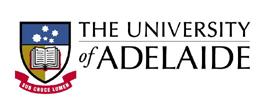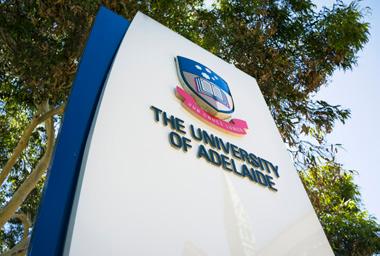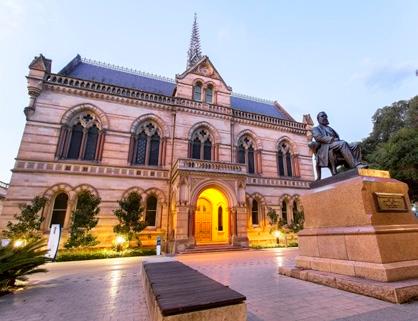
6 minute read
University Spotlight: University of Adelaide
University of Adelaide
Source: Sally Wood
The University of Adelaide stands tall as one of the world’s leading organisations for education and innovation. Founded in 1874, the University became the first in Australia to grant science degrees. In addition, it offered degrees in arts, law, medicine and music before the 1900s. Today, it is a member of The Group of Eight, which includes Australia’s top research-intensive universities.
It consistently features as a high ranking institution, with many international bodies placing the University in the top one per cent worldwide. Over 100 countries are represented in the student population. The total number of students is 21,142, of which 7,868 are from overseas. The University also has an impressive list of alumni, including five Nobel Laureates; Australia’s first Indigenous Rhodes Scholar recipient; and Australia’s first female Prime Minister – Julia Gillard.
The University of Adelaide’s Contribution to Materials Science and the Centre for Energy Technology
The University of Adelaide has generated $181.6 million in total research income, with a strong emphasis on research utilisation. The University’s Centre for Energy Technology (CET) links research teams with end-users in their respective industries. These partnerships work together to develop innovative methods for fuel sustainability, minerals processing and other power needs. The key intention of the Centre is to fast-track Australia’s transition to a carbon neutral economy and environment. It is underpinned by four key research challenges, including: • Sustainable secure power • Sustainable fuels • Sustainable minerals • Sustainable networks and grids. Over 115 researchers and students operate across CET’s 20 projects, which span across unique challenges and scales. Together, the team publishes 170 papers per annum, in leading academic journals, and registers an average of two patents per annum. Professor Gus Nathan leads the team of researchers, whose expertise is focused on energy engineering; particularly in systems relevant to geothermal, solar, and the combustion of fossil and bio-fuels. Professor Nathan was responsible for leading a team which designed the fuel and combustion technique for the relay torch during the 2000 Sydney Olympic Games. In addition, he co-invented the patented combustor used in the stadium flame and torch for the 2004 Athens, and 2016 Rio Olympic Games. CET’s research is divided into nine themes: • Solar thermal • Energy materials • Wind, wave and tidal power • Low carbon materials • Biomass to energy • Two phase flow • Sooting flames

• Chemical looping • Laser diagnostics. Over $12 million worth of infrastructure is housed at CET’s facilities, where international researchers gather to seek solutions to the challenges of the modern world. The nine research themes at CET are supported by state-of-the-art facilities, including: • Energy storage testing facility • Solar simulation facilities • Biomass and coal research laboratory • Photocatalysis laboratory • Wind tunnel • Laser diagnostic systems and research laboratories • Micro-algae cultivation and processing facilities.
ARENA Solar Thermal in the Bayer Alumina Process Project
Researchers that are part CET’s solar thermal research theme, are seeking to achieve 50 per cent concentration of solar thermal (CST) into the commercial Bayer alumina process. The Bayer alumina process involves the heating of bauxite ore, along with a sodium hydroxide solution. This forces the aluminium to dissolve, as a sodium aluminate, as part of an extraction process. The production of calcined alumina in Australia generates over $5 billion each year, and accounts for around 27 per cent of Australia’s industrial carbon emissions. This University of Adelaide’s project intends to establish a path to progressively integrate three CST energy technologies into the Bayer alumina process. The project team has found that the introduction of concentrated solar thermal technologies to the Bayer alumina process, could currently lead to a 29-45 per cent solar share. CET research, as part of this body of work, is separated into three programs: • Low temperature process heat: which seeks to understand the conditions that
CST can be integrated into low temperature process heat for increased evaporation, digestion, and pre-heating.
• Solar reforming of natural gas: which examines the economic viability of generating syngas, through solar reform, for the Bayer alumina process. • High temperature calcination: which investigates if CST can be economically introduced to the calcination stage of the
Bayer alumina process, or directly to the reactor, or indirectly by heating particles. The solar share developed by CET research could potentially alter natural gas reliance, and reduce fuel costs. This $15.1 million project receives funding support from the Australian Renewable Energy Agency (ARENA). The project is led by the University of Adelaide, but also encompasses CSIRO and the University of New South Wales. Its industry partners include Alcoa of Australia, IT Power and Hatch.
High Performance Electrocatalysts Project
Electrochemical devices, such as fuel and water-splitting cells, and batteries, require energy materials to operate. Researchers at CET are creating high performance catalysts to bring greater efficiency to these electrochemical devices. Professor Shizhang Qiao leads research through CET to design these devices for greater use. This may include use in oxygen reduction reactions, hydrogen evolution reactions, and oxygen evolution reactions. The team has used a computational
Heavy Industry Lowcarbon Transition Cooperative Research Centre Proposal
Under the Australian Government’s Cooperative Research Centre (CRC) program, researchers link with government and industry to provide advice and solutions to modern challenges.
Professor Nathan, from CET, led the bid for the Heavy Industry Low-Carbon Transition CRC. “The industrial sector is expected to be the slowest to transform, because theory and other experiments to develop a framework for catalysts. These catalysts focus on the energy material’s chemical and physical structures. Through this discovery, Professor Qiao’s team can offer better performance for cutting edge energy storage and conversion processes.
Wind, Wave and Tidal Power
Another key area of research, for CET, is the optimisation of components in wind and wave turbines. The research works in collaboration with Carnegie Clean Energy, and is aimed at technology that extracts energy from untapped wave energy resources. Associate Professor Nesimi Ertugrul leads the CET team, which is examining the unique elements of wind power. The team is working to optimise wind power generation across Australia’s 52 wind farms. As part of their research, the team has developed an algorithm-based optimisation method that will benefit wind farm design. The software uses computing power and advanced algorithms to test up to thousands of potential network options, which can then inform Australia’s wind farm layouts. Industry partners are already reaping the benefits of the software through a reduction in time, and a corresponding saving in cost, due to the increased efficiencies in the design process.
the technology do this is less well established,” he said. “It is also critical to our national and global economies. There is a growing demand, a lot of economic drivers for this transition, but also environment imperative,” Nathan added. The proposed CRC will focus on three research program areas: • Process technologies: - Blast furnaces - Iron pellets - Steam and calcination - Roasting and drying - New, high value products. • Cross-cutting technologies: - Biomass and waste-derived feedstock utilisation Similarly, wave and tidal power research, undertaken at CET, is focusing on the potentials of ocean energy. Professor Ben Cazzolato and Associate Professor Maziar Arjomandi are modelling electromechanical systems, which are matched with incoming waves for power generation. When captured, wave energy can provide electricity, water desalination, and pump water.


- Hydrogen utilisation, electrification and solar thermal energy - CO 2 capture, storage and re-use - Flexible integration, use of digital twins, and systems engineering. • Facilitating transformation: - Roadmaps, strategy and upscaling challenges - Supply chain and value chain mapping - Markets, policy and regulation - Future industry planning. Each area will be led by a research and industry leader, with the University of Adelaide in the prime seat to drive this next generation of research. If the bid is successful, the CRC will commence in October 2021.










